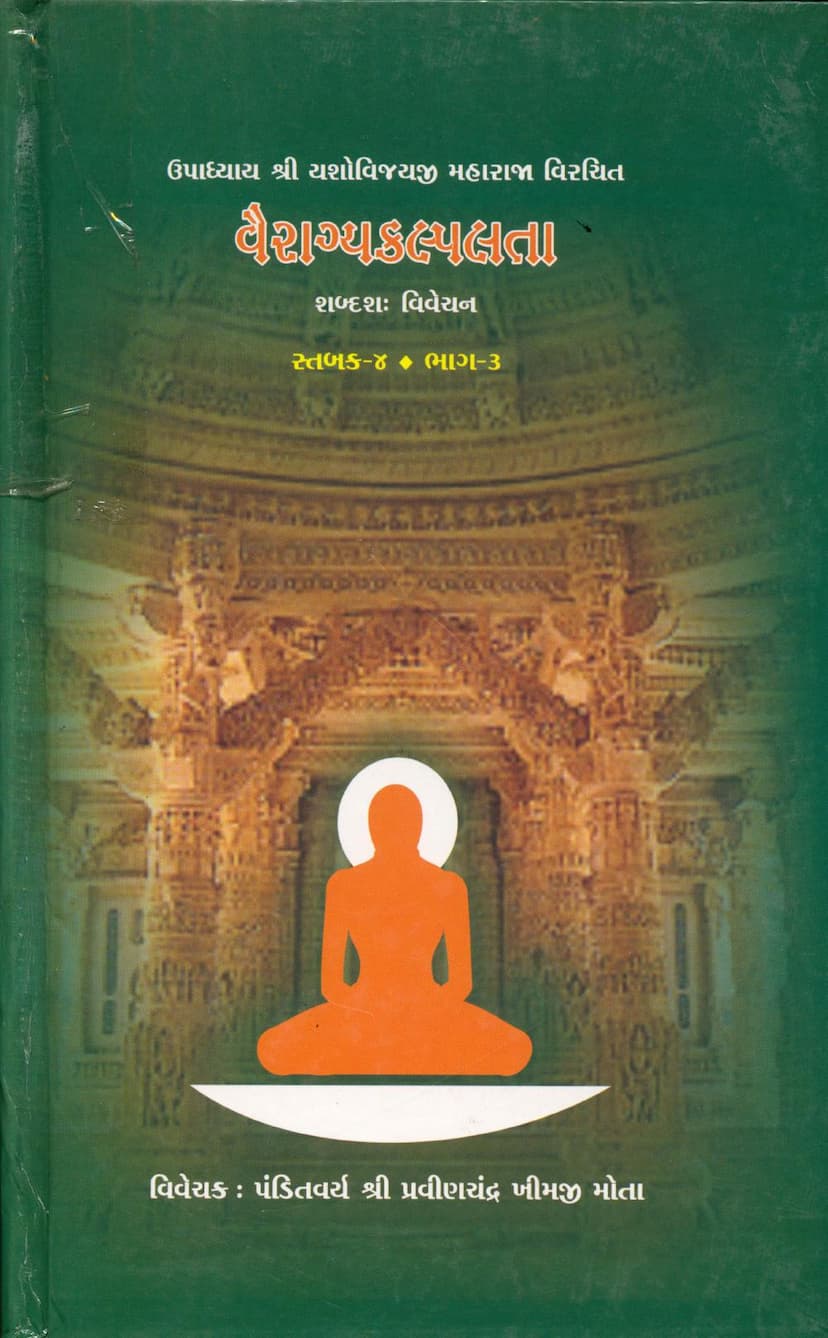Vairagya Kalplata Part 03
Added to library: September 2, 2025

Summary
This is a summary of the Jain text "Vairagya Kalplata Part 03" (in Gujarati), focusing on the content of the provided pages.
The book is a commentary on the original work by Upadhyay Shri Yashovijayji Maharaj, with the commentary written by Pandit P.V. Shri Pravinchandra Khimji Mota. It is published by Gitarth Ganga.
Key Information and Content:
- Title: Vairagya Kalplata (Shatashah Vivechan, Stabak 04, Part 03) - વૈરાગ્યકલ્પલતા (શબ્દશઃ વિવેચન, સ્તબક-૪, ભાગ-૩)
- Original Author: Jain Acharya Shri Padmalabh Suri, Mahamahopadhyay Shrimad Yashovijayji Maharaj - જૈન આચાર્ય શ્રી લઘુહરિભદ્રસૂરિ મહામહોપાધ્યાય શ્રીમદ્ યશોવિજયજી મહારાજા
- Commentator: Pandit Shrimad Pravinchandra Khimji Mota - પંડિતવર્ય શ્રી પ્રવીણચંદ્ર ખીમજી મોતા
- Publisher: Gitarth Ganga - ગીતાર્થ ગંગા
- Blessings/Inspiration: P.P. Acharya Devesh Shrimad Vijay Ramchandrasurishwarji Maharaj and P.P. Muni Pravar Shri Mohjit Vijayji Maharaj - પ. પૂ. આચાર્યદેવેશ શ્રીમદ્વિજય રામચંદ્રસૂરીશ્વરજી મહારાજા તથા પૂ. મુનિપ્રવર શ્રી મોહજિતવિજયજી મહારાજા
- Current Spiritual Guide: P.P. Acharya Bhagwant Shrimad Vijay Yugbhushansurishwarji Maharaj - પ. પૂ. આચાર્ય ભગવંત શ્રીમદ્વિજય યુગભૂષણસૂરીશ્વરજી મહારાજા
- Compilation: Rakhiben Ramanlal Shah - રાખીબેન રમણલાલ શાહ
- Publication Details: First Edition, Vir Samvat 2541, Vikram Samvat 2071, Copies: 500, Price: Rs. 140.00. Published from Ahmedabad.
Foreword (Prakashkiya - Page 4-5):
The foreword emphasizes the importance of understanding the deeper secrets of Jainism, not just its acquisition. It likens a person who has Jainism but lacks its deeper knowledge to someone who has a torch but doesn't know how to use it. The Gitarth Ganga institution aims to illuminate these secrets through 108 main subjects and 10,008 sub-topics. The process involves collecting scriptural verses from various scriptures, resolving apparent contradictions, and revealing hidden meanings.
The work is presented in an accessible style through discourses by H.H. Acharya Vijay Yugbhushan Surishwarji Maharaj. This particular volume is the third part of the fourth chapter (Stabak) focusing on the theme of "Desire for Renunciation" (Vairagya). The publication is presented as a means to provide readers with profound scriptural knowledge, drawing parallels to an encyclopedia.
Content of the Chapters (Stabak 4):
The provided text starts with the Fourth Chapter (Chaturth Stabak) which begins with an invocation and then introduces the concept of the "Samsari Jeev" (the soul wandering in the cycle of existence).
The narrative follows the life of Nandivardhan, the son of King Padma and Queen Nanda. The text details his birth, naming ceremony (Nandivardhan), and his childhood.
A significant portion of the text focuses on the concept of "Avivekita" (unreasonableness/ignorance), personified as Nandivardhan's nurse. The commentary explains how the soul's inherent "Avivek" (lack of discernment) leads to the association with negative qualities and influences.
The text then delves into a detailed, allegorical description of "Vaishvanar", a character representing negative qualities like greed, anger, pride, deceit, etc. This is presented through a physical description where body parts are associated with specific vices. The commentary explains how these negative qualities are deeply ingrained and influence the soul's actions and perceptions.
The narrative highlights the internal struggle and the influence of these negative tendencies on Nandivardhan, even his interactions with his father and the concept of "Punya" (merit). The text illustrates how the "Punya" (merit) in Nandivardhan's case, despite his adverse qualities, tries to guide him, but the overpowering "Avivekita" and "Vaishvanar" prevent him from attaining true wisdom.
The commentary provides philosophical insights into the nature of karma, the soul's journey, and the subtle workings of virtues and vices. It emphasizes that merely having "Punya" or being born in a good lineage is not enough; true liberation comes from overcoming inner impurities and cultivating true knowledge and conduct.
The chapters also explore the role of external influences and the importance of right association (Satsang) and the teachings of Tirthankaras and Acharyas in overcoming the cycle of suffering. The detailed descriptions of Vaishvanar and the associated vices serve as a moral lesson and a guide for understanding and conquering one's inner enemies.
The latter parts of the text introduce other characters and their complex relationships, highlighting themes of attachment, the deceptive nature of worldly pleasures, the consequences of negative actions, and the gradual unfolding of spiritual understanding. The narrative also touches upon the importance of the guidance of a Guru and the significance of adhering to virtuous conduct.
The text uses allegorical characters and scenarios to explain complex Jain philosophical concepts, making them relatable and comprehensible for the readers. The detailed commentary provides a deeper understanding of the scriptural verses, connecting them to the broader teachings of Jainism.